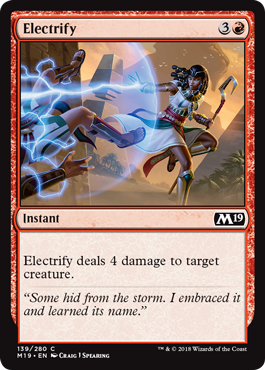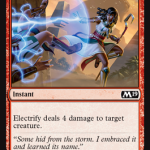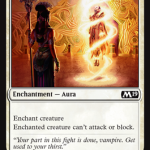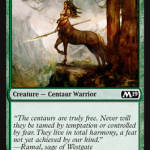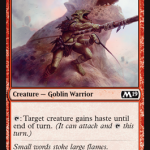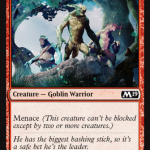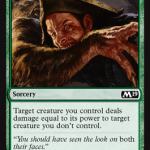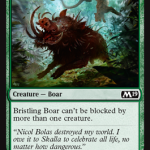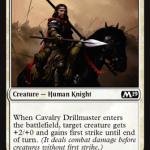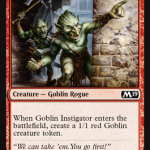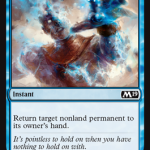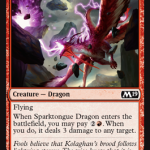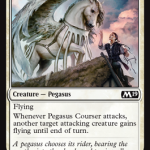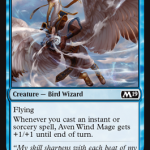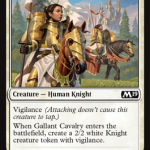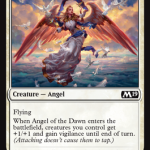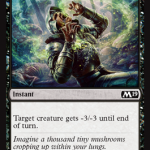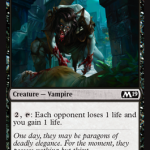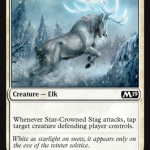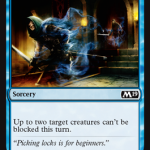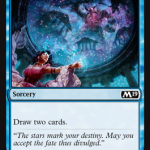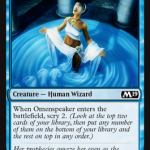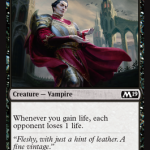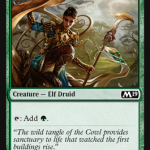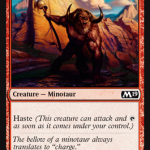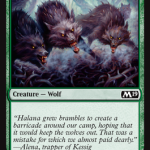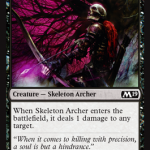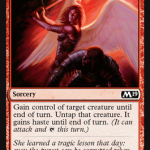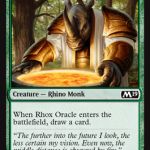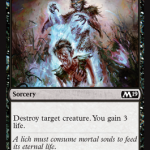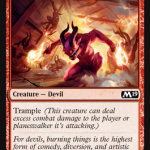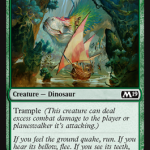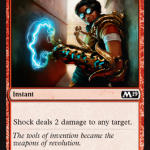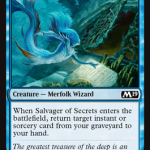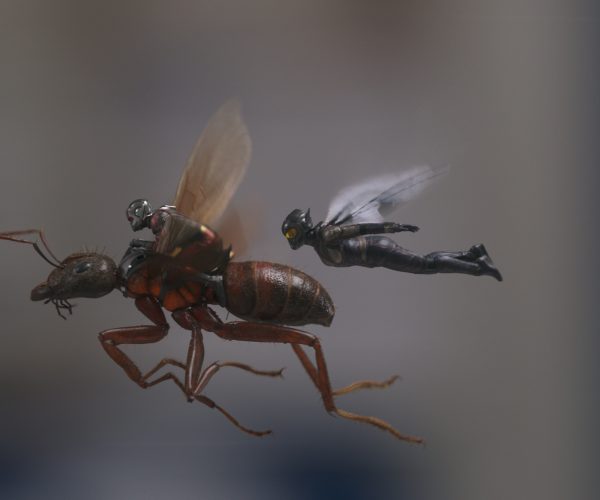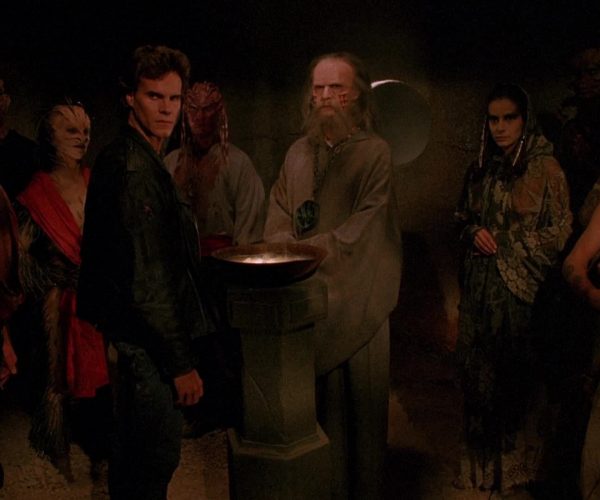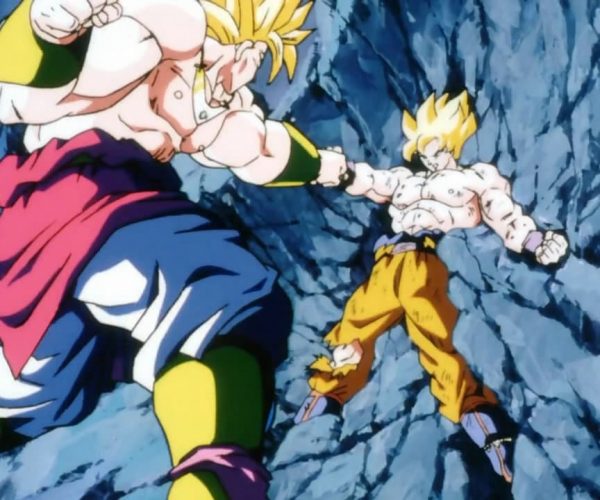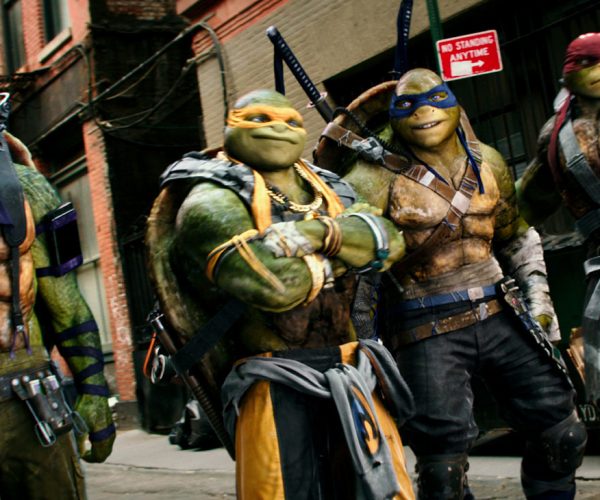Magic: The Gathering’s Core 2019 set is poised to bring back the lost tradition of “core sets” when it releases on July 13. With weeks to spare, Wizards of the Coast has begun its latest season of Magic: The Gathering with the full reveal of every card in the set.
Now on The Nerdy, just as we did before on TechnoBuffalo, we will dedicate a few articles to our favorite cards for Draft and Sealed Limited play. This first article will explain our choices for favorite common cards from each color, and other articles will detail why we love certain uncommons and rares.
Today’s article is all about the guts of the set. In any Limited game of Magic: The Gathering, you would be lucky to get two, three, maybe even four rares in your deck. The vast majority of cards you ultimately choose will be filler to help flesh out the way for your bombs or win you the game before your opponent can find theirs. Naturally, not every card is going to be solid or even playable in any capacity, so we’re here to help you pick out a few to get you started.
As for the set as a whole, Core 2019 has the unenviable task of following up on the brilliance and majesty of Dominaria. Such a beloved and deep set always makes the follow-up seem meek by comparison, and Core 2019 must accomplish this without the fancy, unique mechanics that you usually find in expansion sets. Core sets are all about Magic at its most basic, not about how weird or experimental it can be.
Also, keep in mind that I got back into Magic: The Gathering with Origins and didn’t really start to wrap my brain around the game until I played Battle for Zendikar. This means this is the first time I’ve really had to evaluate a core set!
For now, I think it looks solid, but not half as exciting as Dominaria. Only time will truly tell though. We don’t yet know how fast or slow the set will be, nor will we know how fun it will be until we actually get our hands on it.
WHITE
White brings enough Cards to fill its traditional roles in Magic: cheap creatures to help jam in Red aggressive decks, flood the board to support your big Green baddies, provide enough protection for your Blue flyers and draw spells, or gain you some life in those long, grindy games with Black. White is more of a support color than ever, which means you’ll probably always want to be there but never exclusively be there.
Commons have some nice creatures and removal to talk about.
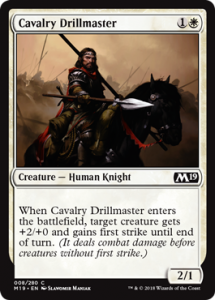
This excellent little card is all I want from a two-drop. It provides an aggressive attack power for early in the game, and it can either act as a removal spell or push an extra 2 damage into your opponent late in the game.
With enough White creatures on the board, no early blockers are going to want to jump in front of your pumped attacker. Either your opponent takes the hit with the 2 points of damage and starts piling on the pressure, or they lose a creature on their board state and have to face down not one but two solid attackers the next turn.
Being a Knight also has some bonuses, just not as many as it did in Dominaria.
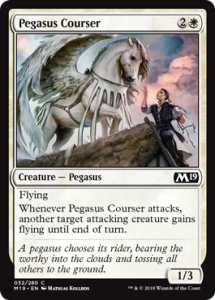
And speaking on Dominaria, I was on the wrong end of this little powerhouse quite often in my drafts. Take a note from my opponents and use this to jam big and small creatures alike over defensive lines. Pegasus Courser will ignore any stalemate you might find yourself in during the late-game, and it can survive most encounters with other cheap fliers.
It gets a bonus for passing the Shock test as well, but Electrify can still bring one down.
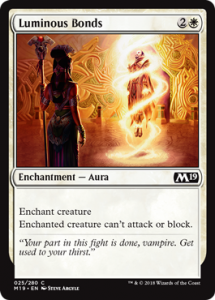
After Ixalan’s Limited play crashed and burned, it took a miracle for Rivals of Ixalan to salvage something out of it. Luminous Bonds was one of the cards that allowed this, adding some much-needed removal at common to aid with breaking up board states and making games more interesting.
We might never see Pacifism ever again in Standard play because Luminous Bonds allows the effect to not seem totally broken. Three mana is the perfect spot for this, and I’d always draft this over the lower tier Elder Dragons and its far clunkier White common removal sibling, Take Vengeance.
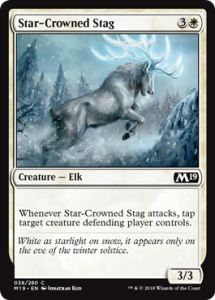
I read this and immediately had happy flashbacks to Territorial Hammerskull, one of the few Ixalan common cards I was eager to keep in my collection. Granted, this comes down a turn slower and won’t help aggressive decks run all over opponents in the same manner as the common Dinosaur once did. Territorial Hammerskull was crazy broken, where as this card seems a bit more boringly fair.
In slower games, this too will help clear the way for creatures to get their damage into the face of opponents, just so long as they keep their creature count down and aren’t flooded with Elf or Goblin tokens.
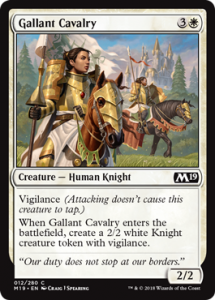
Call the Cavalry was a prized common in Dominaria for Green and White “go wide” decks, and this is even better. Sure, you still get two 2/2 Knights with vigilance, but because Gallant Cavalry is a creature and not a sorcery, that makes it easier to take advantage of with graveyard shenanigans and bounce spells.
4/4 worth of stats across two bodies that never tap for four mana is always a good deal though, no matter how you split it.
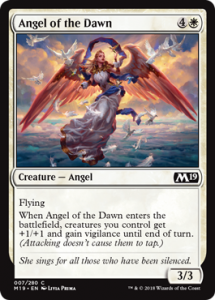
Angels at common are usually playable, and here we have a nice one with some sweet art no less. Five mana for a 3/3 flyer is a fine price in any White deck you’re playing during the late game, but the added effect of pumping your team and giving them vigilance makes this an excellent payoff in a ‘go wide” deck.
Imagine, after being rocked with an army of pumped weenies, opponents will not only lose the ability to crack back effectively, but they’ll also likely surrender air superiority.
BLUE
And I said, White was a support color! Blue in Core 2019 is all about drawing cards, countering, bouncing, and making sure you always have an advantage in your hand while never allowing your opponent to build a board state. Again, this is traditional Magic, and this is what Blue has always been known for.
Add in a bit of artifact support, and Blue is in a decent place.
Just don’t expect to push too much beef with Blue. You’ll need the backing of another color to finish an opponent off.
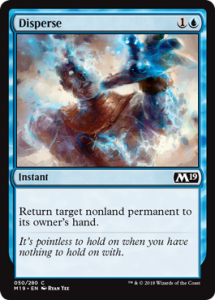
Blue’s removal style is to put cards back into your opponent’s hand, and this is one of the best cards ever printed to get that done. While more expensive than Unsummon, it allows you to target artifacts and enchantments, possibly throwing off your opponent’s entire strategy.
It also allows you to snatch back your own creatures in a pinch if you want some value from Enter the Battlefield effects. This versatility always makes it a hard card to pass in a draft.
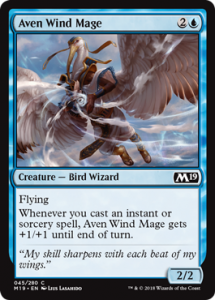
A potential finisher for Blue. Prowess is nowhere to be seen in Core 2019, which makes me a sad prowess fan, but this “almost prowess” can get the job done, especially in a dedicated Red/Blue spells deck.
Blue flyers usually overperform in Limited Magic, and I see this one as an early favorite. It doesn’t pass the Shock test, but a Shock or Disperse of your own can push it easily out of range.

Omenspeaker is always a favorite in Blue at common. For two mana, you get a decent blocking body and card advantage through scry 2, which is almost as valuable as drawing a card. Play it early to filter lands and block pesky aggro creatures. Play it late to put your bomb on top and survive an extra turn. Bounce it, recur it, find multiple ways to take advantage of it.
Great card for any Blue control fans.
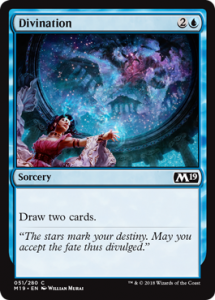
The power of Divination always depends on the speed of the set. In Dominaria, it was a bomb common that everyone wanted at least one copy of. Here, we’ll have to wait and see what kind of decks emerge as the strongest.
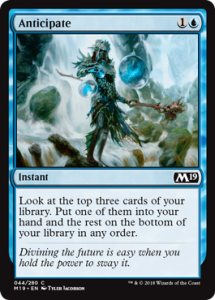
However, Anticipate is a clear choice over Divination since it is cheaper, castable at instant speed, and it lets you fish out the card you want rather than two that you might not need. We’ve been spoiled by Opt over the last few sets, so maybe Anticipate will bring instant speed card draw back down to Earth a bit.
BLACK
Black is all set to blow up your opponent’s creatures and drain their life away slowly. Vampires are now the mainstay of Magic: The Gathering, and in Core 2019, they return equipped with life draining abilities, life-gain triggers, and the gift of flight.
Plus, it has its usual helping of creature removal, just in case your opponent drops a big baddie your flimsy undead soldiers can’t handle.
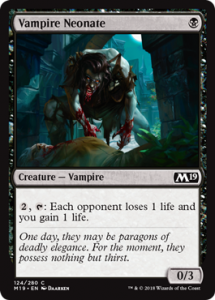
Nice little card. This comes down on turn 1 and can keep anything small at bay for two or three turns. It prevents flooding early in the game by granting 2-point life swings, and it helps chip away those final few points of damage in the late game with unblockable damage.
Vampire Neonate passes the Shock test, provides a nice mana sink, and is all around a solid, versatile card for just a single mana.
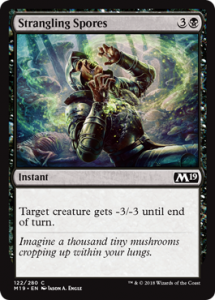
Black’s common instant removal provides a way to kill off smaller creatures on the spot while circumventing indestructible and regeneration texts. It can’t take down bigger creatures outright, but with proper blocks, it can catch an unprepared attacker off guard.
Strangling Spores is exactly what Black wants as a common removal spell, and so is its companion.
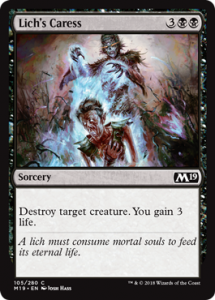
Boom, dead! It’s no Vraska’s Contempt, but this efficient removal will get the job done in most cases. I would take the cheapness of Eviscerate or the treasure tokens from Contract Killing, but this will emerge as Black’s premier removal spell in Core 2019.
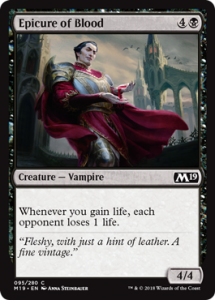
4/4 for five mana lies on the overpriced side of things, but in a dedicated life-gain deck, this damage will pile up in the late game. Multiples will stack and drain opponents even faster, and if all else fails, 4/4 really isn’t all that shabby of a body.
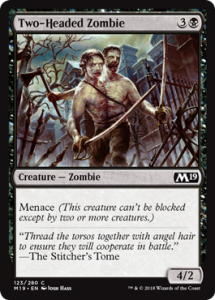
And if all else REALLY fails, why not just jam in with an evasive threat that must be blocked unless your opponent wants to take some serious damage? This is solid filler that will help you close plenty of games. Teaming up with Strangling Spores will make combat a total blowout for an opponent.
RED
Red, as usual, is all about direct damage and efficient creatures that push combat damage through. In Core 2019, it’s a bit on the shallow side at common with not much but typical burn spells and a host of creatures that have come equipped with a single evergreen ability. Let’s say that Red has been heavily overpowered in recent years, so it’s nice to see it take a back seat…
…and watch as that comment bites me in the butt later.
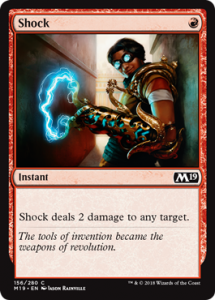
Oh man… it’s hard to tell where this will land on the power charts. This rocks in a set like Amonkhet where there are valid targets who are wimpy on the toughness side, but it can be equally useless if all it’s going to do is finish off creatures post-combat or go right to the face.
My guess is that it will be the former in Core 2019. I see plenty of creatures with 2 or less toughness that need to be removed on the spot, Two-Headed Zombie among them.
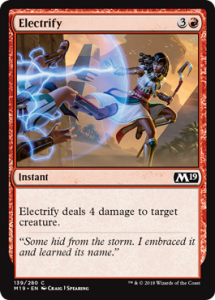
And here we have a bigger removal spell that will kill most anything at a higher price tag. This picks off a much larger range of creatures, but will it be worth the cost? Yes, this is a solid card, but I’ll still be taking Shock over it.
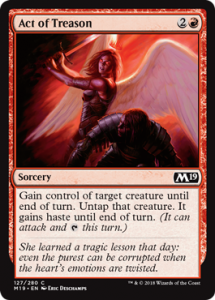
Act of Vengeance is a fun card wherever it turns up, but its usefulness depends entirely on how many sacrifice outlets a set has. With cards like Ravenous Harvey, Demon of Catastrophes, Blood Divination, Dark-Dweller Oracle, and Thud, you’re likely to stumble across at least one or two, making this a nice treat if you do.
Don’t draft it before any sacrifice outlets though since there is nothing at common that will aid you in that department. You’ll want usage for it before you take it.
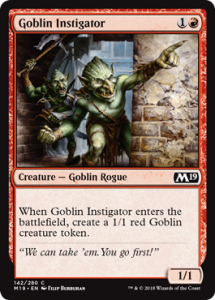
Much like Gallant Knight, Goblin Instigator is a Dragon Fodder attached to a creature spell. Recursion, bounce, play it all over again. I don’t see a whole lot of payoffs for going wide with Goblins in Core 2019 draft unless you are sacrificing them for better spells, but anybody who has played Magic knows that nothing gums up the board better than Goblin tokens.
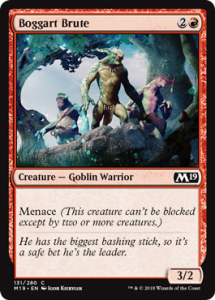
Red has three basic evergreen creatures at common, two of which aren’t overly impressive. There’s a 3/3 haste Minotaur for four mana, which might catch an opponent off guard here and there, and 4/3 trample Devil that easily dies to creatures of lesser value and will not get much damage through.
Boggart Brute is easily the winner of these three thanks to its low cost and the immeasurable power of menace. A 3/2 menace attacks well both early and late in the game, and it can even block and trade for some early Green threats with a play on turn 3.
Speaking of which.
GREEN
Here we go! Green is gonna be Green, and man oh man does it deliver in Core 2019. Ramp, card draw, big creatures, Green is the color I love the most in Magic, and this set is a solid reminder of why.
And we’re starting off with an old friend.
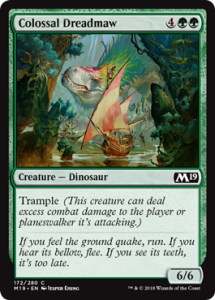
Wizards of the Coast can troll me all they want. I still love this card, and I will always stick by it when it gets reprinted. Colossal Dreadmaw has now appeared in four of the last five sets of Magic: The Gathering, and that’s because it does exactly what Green wants.
For six mana, you get a 6/6 power creature with trample. Cleanest transaction you can make in Green’s brand of Magic.
I said the same thing in M25, and it makes even more sense here. Core sets are all about educating players how to play the basics, and this is, at its core, the most pure Green card ever printed, alongside Llanowar Elves of course. One that will always make the cut if I’m drafting the color in Core 2019 or any set it gets reprinted in from here on out.
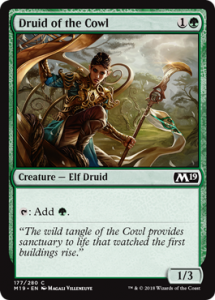
And you’re going to want to cast your Colossal Dreadmaw or any other threats as quickly as you can, which means you need some ramp. We were spoiled to tears in Dominaria with the reprinting of Llanowar Elves, so the good times are over. We’re now back to two-drop Green mana dorks, and at least we’re seeing a solid choice here. Druid of the Cowl survives Shock, it can block well, and it can survive long enough to complete its primary task of dropping the big guns.
If you’re Green and you pass this for any other common, even Colossal Dreadmaw, you’ve missed out.
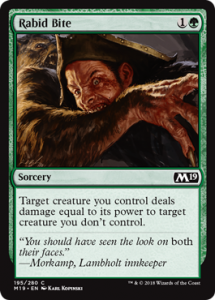
This card tore through Shadows Over Innistrad with the help of bulky werewolves, and it’ll do the same here. With a single big threat on the board, Rabid Bite could only be a better removal spell if it was an instant. It deals direct damage, meaning your creature doesn’t take damage in return, and I’ve yet to see any creatures in Core 2019 that can slug it out with a Colossal Dreadmaw or any of Green’s other mighty brutes.
Giving Green a direct removal spell wouldn’t be fair to the rest of the colors Magic, so this is enough of a compromise to keep the playing field fair while still being a powerful card.
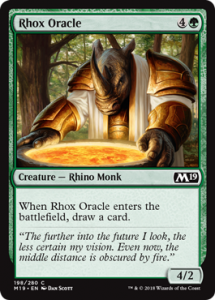
Pro tip: Rhinos are my all-time favorite animals, but I’ve never had the chance to really play with the Rhox clan outside of Rhox Maulers in Origins. That changes here since I’m always playing this. Rhox Oracle attaches a strong body to a draw spell. It’s a bit steep at five mana, but it’s also a common that essentially pays for itself.
4-power will also allow this to trade up often, and when tied to a Rabid Bite, it becomes even more deadly. Sadly, it dies to Shock, and if you’re playing against Red, beware of getting 2-for-1’d by removal.
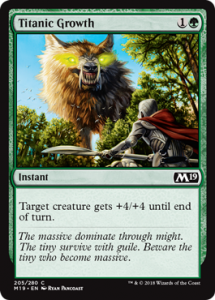
Titanic Growth provides a very powerful effect for just two mana. Combat tricks act as Green’s other method of removal, and if your opponent doesn’t bite, then it provides a blowout with 4 additional damage stacked on top of your powerful Green threat.
I’d still take Giant Growth in a pinch, but this more than suffices.
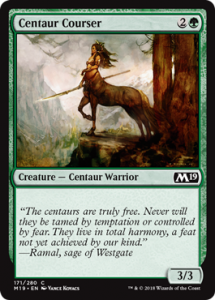
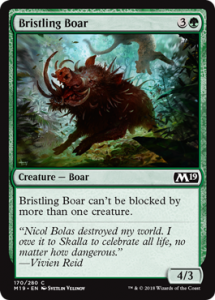
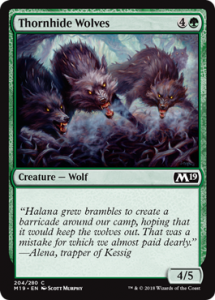
Three more solid creatures I would like to give a nod to at common. A 3/3 for three mana is always a good deal, and it piles on the pressure for opponents early in the game when they have no answers. And a 4/3 for four mana that can’t be ganged up on will chew up a few chump blockers before trading for something even bigger. And a 4/5 for five mana is a bit overpriced, but I don’t see many answers for it in the other colors.
Thornhide Wolves is always powerful on any battlefield it gets summoned to, and it’s possible it can emerge as a solid bit of filler just like it did in Shadows Over Innistrad, even without the wolf synergies.
While I still love Colossal Dreadmaw, I’m keeping an eye out for these three solid beaters as well.

